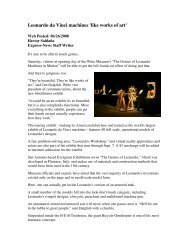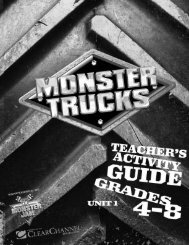Extreme Deep Teacher's Guide.pdf - Evergreen Exhibitions
Extreme Deep Teacher's Guide.pdf - Evergreen Exhibitions
Extreme Deep Teacher's Guide.pdf - Evergreen Exhibitions
Create successful ePaper yourself
Turn your PDF publications into a flip-book with our unique Google optimized e-Paper software.
<strong>Deep</strong>-Sea Scavenger Hunt<br />
OBJECTIVES<br />
Students will discover that...<br />
■ they have a lot in common with the deep sea<br />
and deep-sea explorers.<br />
■ one way to make sense of something is to think<br />
about how it’s like something more familiar.<br />
BACK<br />
CKGROUND<br />
INFORMA<br />
RMATION<br />
By now your students should be pretty good<br />
explorers. And they should know quite a bit about the deep sea. Here’s a chance for them to<br />
combine their new fields of expertise and demonstrate how well they know their stuff.<br />
ACTIVITY<br />
Materials<br />
■ shoe boxes or other containers for collecting items (one for each team)<br />
■ one copy of the Scavenger List for each student<br />
■ prize or prizes<br />
Questions to Begin<br />
■ none<br />
S U B J E C T S<br />
life science, oceanography<br />
G R A D E S<br />
6 - 8<br />
C O N C E P T S<br />
deep-sea environment<br />
D U R A T I O N<br />
one 20- to 30-minute class session to<br />
present the scavenger hunt; one 45-minute<br />
class session to review each team’s findings<br />
Procedure<br />
1. Copy the Scavenger List and give one to each student.<br />
2. Split students into teams of two or three. Each team is to find an everyday object for as many<br />
clues on the Scavenger List as possible. When students find an object that matches the clue,<br />
they are to store it in their team’s shoe box.<br />
3. When the everyday objects are living things or belong to someone else, encourage your<br />
students to bring photos or make drawings rather than collect the real thing.<br />
4. Give the class two to three days to collect objects and to complete their lists.<br />
5. At the end of the given time period, have each team present their results. Instruct them to<br />
identify each object and the category it represents, and to justify their answers.<br />
39





